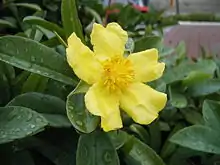Hibbertia scandens
Hibbertia scandens, the snake vine, climbing guinea flower, golden guinea vine or gold guinea plant, is a species of flowering plant in the family Dilleniaceae, native to Australia but widely cultivated. Growing to 4 m (13 ft) in length, it is a climbing or sprawling evergreen shrub with glossy leaves and solitary, bright yellow flowers.
| Hibbertia scandens | |
|---|---|
 | |
 | |
| Fruit, Palm Beach, NSW | |
| Scientific classification | |
| Kingdom: | Plantae |
| Clade: | Tracheophytes |
| Clade: | Angiosperms |
| Clade: | Eudicots |
| Order: | Dilleniales |
| Family: | Dilleniaceae |
| Genus: | Hibbertia |
| Species: | H. scandens |
| Binomial name | |
| Hibbertia scandens | |
 | |
| Collection data for H. scandens from the Australasian Virtual Herbarium | |
Description
The yellow flowers have been reported as having an unpleasant odour[1] variously described as similar to mothballs[2] or animal urine[3] or sweet but with "a pronounced faecal element".[3] The leaves are elliptic or obovate and average 6 cm in length. The fruits consist of segments of bright orange flesh, each surrounding a black seed. While the flesh looks attractive enough to eat, it is best not to. A minute or so after eating, the flesh produces an unpleasant burning sensation in the mouth and lips.[4]
Near the sea plants tend to be densely hairy with spathulate leaves and flowers with 6 or 7 carpels, while inland, the plants tend to be smoother, with flowers having 3 or 4 carpels.[5]
Taxonomy
The species was first formally described in 1799 by German botanist Carl Willdenow who gave it the name Dillenia scandens. The specific epithet scandens is derived from Latin, and means "to climb". In 1805, Swedish botanist Jonas Dryander transferred the species into the genus Hibbertia.
Distribution
Hibbertia scandens occurs in an area that extends from south-eastern New South Wales upwards to north-east Queensland. Australasian Virtual Herbarium data show records for New Zealand and for New Guinea.[6]
Cultivation
This species is cultivated as an ornamental, and adapts to a wide range of growing conditions. Although it readily grows in semi-shaded areas, it flowers best in full sun. As it is only hardy down to 5 °C (41 °F) it requires winter protection in temperate regions. In the UK it has gained the Royal Horticultural Society’s Award of Garden Merit.[7][8]
In popular culture
Hibbertia scandens appeared on an Australian postage stamp in 1999.
See also
References
- "Environmental Protection Agency - Queensland Government - Snake Vine (Hibbertia scandens)" (PDF). Archived from the original (PDF) on 2011-03-21. Retrieved 2010-11-19.
- Indigenous plants of Greater Taree (third edition) (PDF). Greater Taree City Council. 2010. Archived from the original (PDF) on 21 March 2012. Retrieved 31 January 2012.
- Hawksewood, Trevor J. (31 August 1992). "Diphucephala benhardti sp. nov.(Coleoptera: Scarabaediae:Melonthinae) from heathlands of north-eastern New South Wales, Australia and its association with Hibbertia flowers (Dilleniaceae)" (PDF). Giornale Italiano Di Entomologia. 6: 109–117. Archived from the original (PDF) on 8 July 2011. Retrieved 15 February 2010.
- Rainforest Seedlings
- Harden, G.J. & Everett, J. 1990. "PlantNET: Hibbertia scandens. Flora of New South Wales, 1". Retrieved 1 May 2018.
- "Australasian Virtual Herbarium: Hibbertia scandens map". AVH. Retrieved 1 May 2018.
- "RHS Plantfinder - Hibbertia scandens". www.rhs.org. Retrieved 6 March 2018.
- "AGM Plants - Ornamental" (PDF). www.rhs.org. Royal Horticultural Society. July 2017. p. 48. Retrieved 6 March 2018.
External Links
| Wikimedia Commons has media related to Hibbertia scandens. |
| Wikispecies has information related to Hibbertia scandens. |
- "Hibbertia scandens' (Willd.) Dryand". Australian Plant Name Index (APNI), IBIS database. Centre for Plant Biodiversity Research, Australian Government.
- PlantNET - New South Wales Flora Online Hibbertia scandens
- Australian Native Plants Society (Australia): Hibbertia scandens